

Horizontal Palmar Crease
Masukake-gata (Japanese)
Palmar Single Flexion Crease
Simian Crease
Simian Fold
Simian Line
Single Palmar Crease
Single Palmar Transverse Crease
Transverse Palmar Crease

CHEIROGNOMANCY
CHEIROMANCY
CHIROGNOMY
CHIROMANCY
DERMATOGLYPHICS
PALMISTRY
PALM READING
PHYSIOGNOMANCY

I had a somewhat difficult time orienting to palmistry because of my palms. the conventional palmistry sources in published popular volumes either didn't cover simian lines or associated them with madness/genius. I have what is called a single 'simian crease' on my right hand, also known as 'masukake gata'. the stellar creases in the center of my palm form a little amphitheatre there under my middle finger. both hands have vertical, knife-like lines and valleys under the ring fingers. my right hand also has a light but limited Fate Line extending from the middle finger down to intersect and entangle with the Life Line.
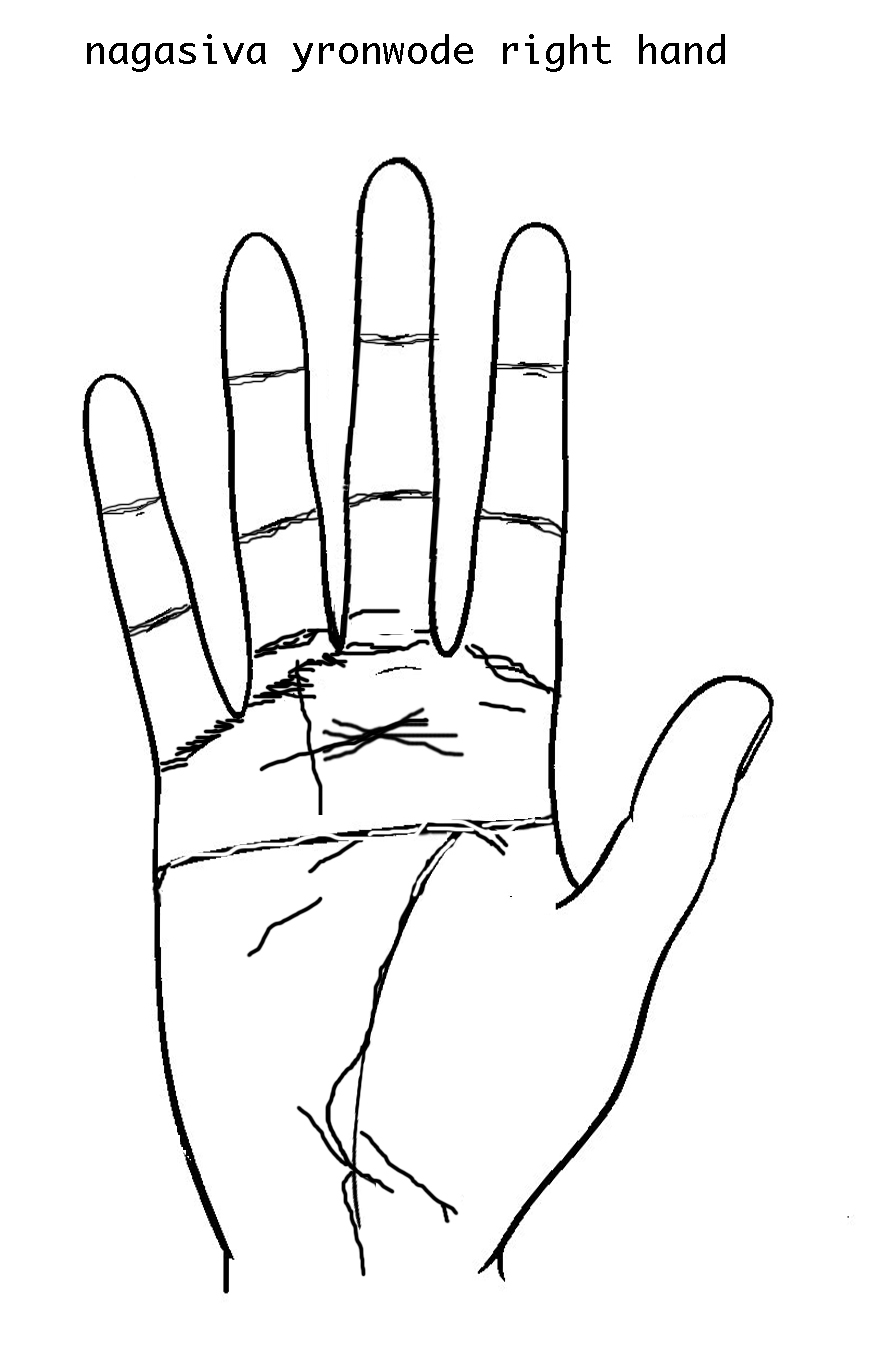
my left hand is trying very hard to be another masukake with its Heart/Emotion Line being 'captured' by the Head/Intellect Lineat the extreme left between thumb and forefinger, forming a kind of awkward trident-shape, an angular E, 3 tines to the right, ultimately 1 to the left. another, broken line continues along the turning arc of the Life Line, going straight up which makes the whole appear a faint capital letter K. Asano even seems to consider this a masukake hand.
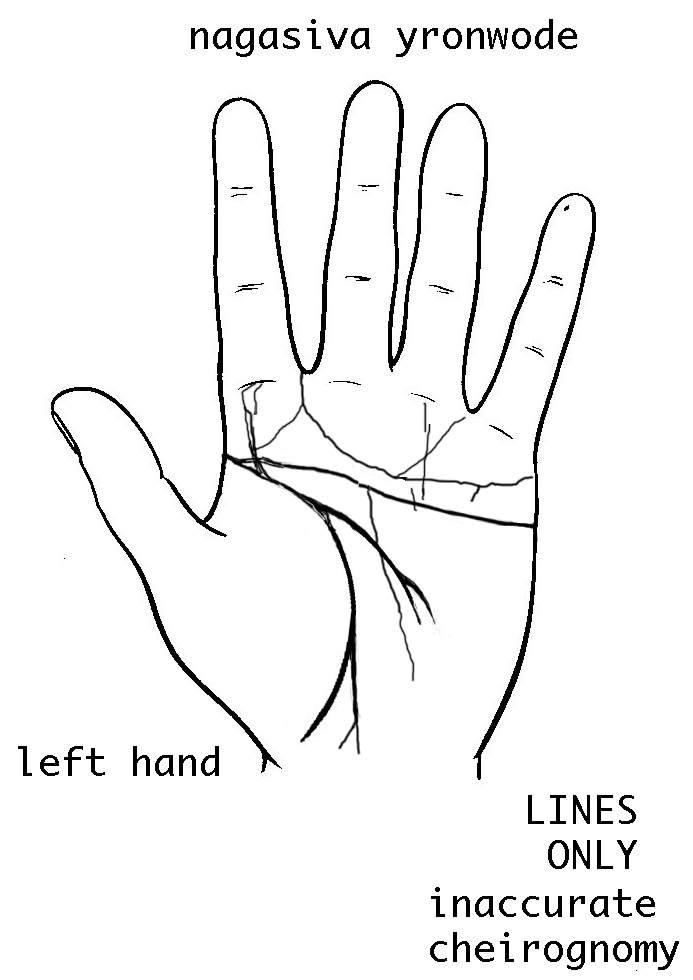
after the first batch of "insane/genius" references i came across i began considering them less than helpful. it wasn't until i ran across a book by an Asian man (Mr. Asano) that i saw any palmistry detail with any depth. the rest simply, it turns out, had eurocentric palmists. Mr. Asano keyed me into the special status which 'masukake gata' hands enjoy in China, Japan, and other parts of the East. gods, buddhas, kings, and geniuses are associated with palmar creases, particularly they are said to be people who are capable of great change as a result of some work born of their hands.it wasn't until just this last year that i began running into more coherent analyses which have global implications, interpreting the Head and Heart Lines as fused and disclosing the virtues and problems associated with this. the implications seem fairly plain, the extremes less obvious. why the more modern convention focusses on communication issues is interesting, but both toned down emotion and occasional communication difficulties seem applicable in my case.
Introduction
From such evidence as three lines carved in the hands of idols dating from those times, it has been supposed that palmistry originated in India and the Middle East in about the second or first century B.C. Even when the palms are visible, there are no wrinkle lines in statues from comparable periods in Egypt or Greece. Indications of the lines on palms do not occur in European painting and sculpture till comparatively late, at a time after contacts had been established with the culture of the Orient. The hands of statues of Christ and some saints perserved in a church in Sicily show such lines clearly.
...
In ancient India, the art of Samudrika was used to judge personality and fate from a person's face, hands, and body in general. Kings are said to have employed it in choosing servants and in selecting the ideal wife. The classic called the Ananga Lunga contains a detailed account of such methods of discrimination, including Samudrika. Judging on the bases mainly of the hands was called Hasta Samudrika Shastra or hastarika, an art that dealt with the shapes of the hand and fingers and with the patterns formed by lines and wrinkles on the palms. No doubt the designs seen on the palms and soles of Indian Buddhist statues are related to hastarika.
In general Buddhist sculpture and painting use positions of the hands to express spiritual and psychological meaning in the form of what are called mudras -- hand positions of Buddhas, bodhisattvas, and divinities indicating attitudes or vows. There are six basic positions, each of which has a full Buddhist religio-philosophical explanation.
...
The absence in their otherwise realistic sculpture of creases and lines indicates that the ancient Greeks were uninterested in palmistry. In contrast, in Indian and other oriental Buddhist sculpture, creases and lines are rendered clearly and in different ways to represent the characteristics of the particular Buddha: strong and vigorous for powerful masculine figures and gentle and romantic for feminine ones. The presence of lines and creases on the palms of such Buddhist statues is less widely recognized. In general, there are three patterns of creases, [F1, BH 3, and AL 3]. The most common one is [F1, the masusake gata], which is found on the palms of many Japanese Buddhist statues, including the colossal Vairocana Buddha of the temple Todai-ji, in Nara. According to ancient doctrines of palmistry, this pattern is the most noble possible to human beings and an attribute of kings. Using it on sculpture representing them means that Buddhas are the loftiest and most ideal form of humanity. In Japan, this palm pattern occurs in no more than seven out of every one hundred people and is often found in members of families of genius.
...
I have already commented on the absence of these crease patterns in realistic ancient Grecian sculpture. The same absence is notable in most other Western sculpture and painting, with the exception of some early Christian art. And, when creases are represented in these early Christian works, the pattern is usually [AL 3].
Their occurence in Buddhist art and absence elsewhere suggest that attempting to evaluate a person's personality and fate on the basis of the palm is related to Buddhism and probably originated in India of the first millenium B.C.
But oriental palmistry did not originate as an independent field. Instead it was an adjunct of physiognomy, or the science of judging a person on the basis of his facial features. The first written works about this field of multifaceted research appeared in China in 1122 B.C., during the Zhou dynasty.
from
Hands: the Complete Book of Palmistry,
by Hachiro Asano, Japan Publications, Inc., 1985,
pgs. 16-19. ISBN:0-87040-633-7
My own investigations have shown that right and left palm patterns are almost the same in 61.01 percent of cases examined and that the percentage tends to be slightly higher for females. The palm pattern called in traditional Japanese palmistry masukake-gata and considered the most unusual variation occurs in 4 percent of left male hands but only in 2.2 percent of right male hands. In 20.1 percent of all left hands examined, all three basic palm lines were distinct and clear; in right hands, this was true in 17 percent.Ibid., pgs. 51-52.
Type F
Considered the ideal and symbolizing great nobility, this palm type (called the *masukake* type in Japanese ) is associated with a powerful, commanding personality and is often used in sculptural representations of Buddhas. Anthropologically it is more common in oriental than in occidental peoples.
Japanese -- 6.0 %
Ainu -- 2.2 %
Chinese -- 13 %
Swiss -- 1.2 %
Dutch -- 1.5 %
Gypsies -- 14.3 %
Koreans -- 11.2 %Since on the basis of the occurrence frequency of this hand pattern, it is possible to estimate the racial associations of a people, it would seem that such data could be a useful clue in attempting to solve the much disputed origin of the Japanese.
In Japan, distribution of this palm pattern is greater in the western than in the eastern part of the country: 9.2 percent of Kyushu as compared with 4.0 percent for eastern Japan.
The English scholar Wood Jones (Principles of Anatomy as Seen in the Hand, 1920), who discovered the similarity between this pattern in human hands and the prevailing pattern in simian palms, named it the Simian Line.
People with this type hand are strongly individualistic and emotionally irregular. Though they may become very angry, they do not give the feeling surface expression. Their appearance and their true emotional state are often very different. Though apparently having a sense of humor and caring for the feelings and needs of others, underneath, they are frequently very chilly people. Socially they tend to be among the elite and capture general attention because of their excellent performance as early as primary school. In Japan, among leaders in all fields are many people with this hand pattern, as there were among the great generals of the Period of Warring States (1467-1568), one of the most violent transitional times in Japanese history.
Though frequently found in persons of genius, Type F occurs often among children who, for one reason or another, are difficult to deal with: for instance, amongt the mentally retarded or among children with organic abnormalities. ...
People with this type of hand tend to succeed in occupations requiring manual dexterity -- surgery, engineering, architecture, shiatsu -- and in such other fields as television entertainment, work demanding original ideas, big business, music, writing, and so on.
Type F may be subdivided into (1) Perfect F; (2) the Imperfect F; and (3) Complicated F, which resembles (2) F....
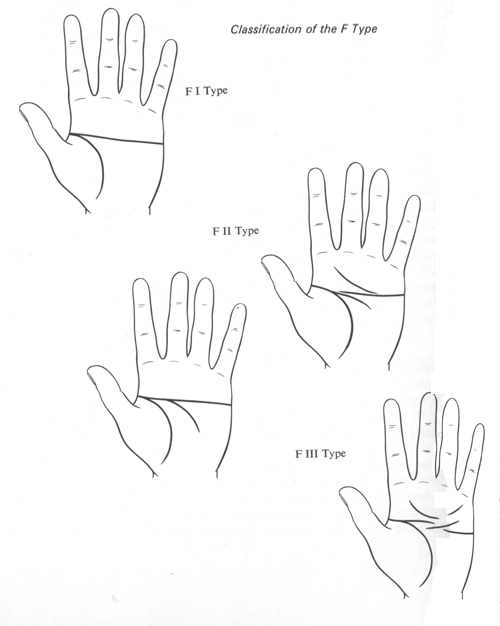
(1) Perfect F Type
A single, strong and clear line cuts across the palm horizontally. Fine creases are few. Easily transmitted hereditarily, if both parents manifest it, this pattern will certainly emerge in the children. Type (1) F, the most commonly encountered of the F hands, is often seen in technicians; doctors (especially surgeons, radiologists, and dentists); engineers, and scholars. People with it frequently have IQs of above 130 and usually have good powers of judgement and analytical thought. On the surface rather ordinary, peole with this type of generally popular and well liked and are more valorous and brave than might be foreseen. Though they seem aloof, they are actually considerate and kind. Giving their all to any kind of work they undertake, they usually play leading roles.
But people with the Perfect F hand find it so difficult to meet marriag partners that men with it usually do not wed until their thirties and women in their late twenties. They are ideally suited to driving automobiles or any work requiring skill with machinery.
(2) Imperfect F Type
The three lines come together in one place; and there are numerous fine lines in the palm in this pattern, which is common among women. Such people are usually nervous and frequently shock others with misanthropical and unusual behavior.
In childhood and youth they are often physically frail and especially afflicted with bronchial and cardiac ailments. But they have good artistic stense and perception and are frequently people of genius. Like the preceding one, the (2) F Type is easily transmitted genetically and has a high likelihood of appearing in twins. People with it tire easily. They fall passionately in love but usually let chances to get married pass them by. In money matters, their fortune is good. They make money easily and tend to be fond of gambling.
Complicated F Type
In this the rarest of the F Types, which occurs in no more than one person in every hundred, all three basic lines overlap; and the entire palm is crisscrossed with a spider web of lines and creases that the Life, Intellect, and Emotion Lines are indistinguishable. It is found in people with congenital disorders. In childhood, such people are frail and seem to suffer from endocrine illness. They are, however, imaginative and often prove to be geniuses of musical composition or other creative work. They often suffer emotional loss because they are self-giving and self-sacrificing in love. A certain childishness persists in their personalities into adulthood. Women with this type tend to be emotionally disturbed at menstruation time. Newborn infants with this pattern cry at night and do not develop in the normal way.
Classification of Characteristics of Type F
In this pattern, which cuts horizontally across the palm, it is frequent for the Intellect and Emotion Lines to be missing. Type F may therefore be divided into the following three subdivisions. [See below.]
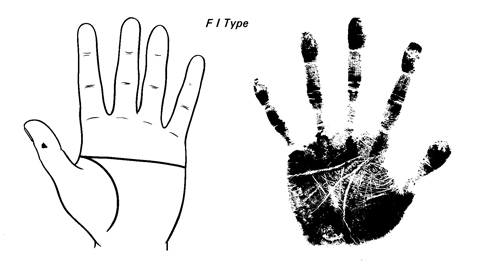
Type [F1]
The perfect version in which one simple line cuts straight across the palm and there are few small lines and creases.
Type [F2]
Either the Intellect or Emotion Line is present with the line cutting straight across the palm. In other words, all three basic lines have come together in one place.
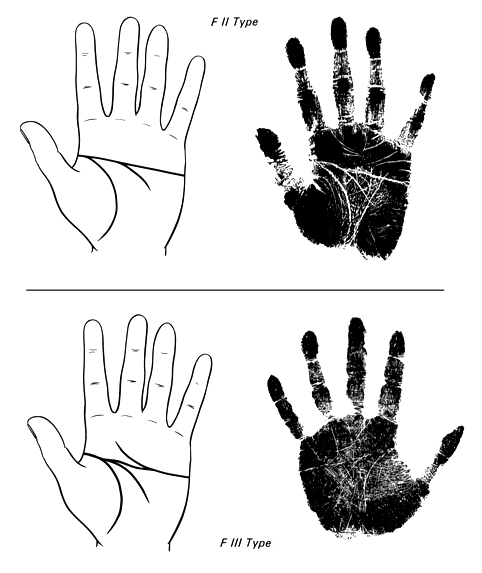
Type [F3]
Though it cuts straight across, the Emotion Line is irregular because of the presence of many small creases over the entire palm. Furthermore, it is not a single line, but a number of intertwined lines.
...
Genetic Influences
The three basic lines are readily transferable genetically. After having examined the hands of 3,775 infants and of their parents, I have come to the conclusion that the characteristics of the parents' palm patterns are reflected in similar patterns in their children's hands. And Type F, in which a single line crosses the palm horizontally, is the one most susceptible to genetic transmission. Even if only on parent has this so-called masukake palm pattern, characterized by two instead of the normal three basic lines, it is highly likely to appear in the children's hands.
Coming to a similar conclusion after examining the hands of 62 families, the German anthropologist H. Schiller said that, when both parents demonstrate it, the masukake patterns [sic] occurs in the children's hands with more than triple the ordinary rate of probability. When the Life and Intellect Lines of the patterns of both parents overlap at their starting points, it is highly likely that the same characteristic will be manifest in the children's hands too.
In six out of ten cases, when the starting points of these lines are separate in the palms of both parents, they will be separate in the palms of the children. In such instances, children rarely demonstrate either the pattern in which the starting points overlap, or the masukake pattern.
In 1942, Schiller studied similarity in the palm patterns of twins and learned that in identical twins the similarity was great in 74.4 percent of all cases studies [sic]. In fraternal twins, on the other hand the patterns were often different and could be said to resemble each other slightly in only 28.4 percent of the cases studied.
Although as of yet our understanding of the effect of genetic transmission is inadequate, the consierable difference in the occurrence rates of the patterns according to race and region suggests that the influence of heredity is great.
Ibid., pgs. 71-76.
[F1] Type
Easily transferred hereditarily and frequent in families of genius, this hand pattern often occurs in technicians, doctors, engineers, and scholars. On the surface ordinary, such peopel are usually courageous, popular, and beloved. Generally they have the genius to be first in their class from the time of primary school. They do well in any work they undertake. The hand of Tokugawa Ieyasu (1542-1616), one of the greatest political figures in Japanese history, was of this pattern.But such people often suffer because it is difficult for them to find marriage partners. They usually marry late: in the thirties for men and the late twenties for women. They make excellent drivers and are well suited to mechanical work or tasks requiring manual techniques.
[F2] Type
This pattern is rare even among the F Types. People with it are often frail from childhood and have weak constitutions. But they have many excellent ideas, put their extraordinary taste to good use, and are often geniuses in musical composition and other creative work.Devoted in love, they sacrifice themselves for members of the opposite sex and sometimes suffer loss as an outcome. Always preserving a certain childishness, women of this type are violently emotionally upset at about the time of menstruation. Newborn babies with this pattern cry at night and do not develop as well as they should.
[F3] Type
This pattern is seen often in women. But both men and women with it are nervous, have violent likes and dislikes in human relations, sometimes suffer from insomnia, and are emotionally inconsistent. They have an artistic flair and are sensitive to beauty. They are good at singing and other kinds of entertainment and often become famous in such fields.Like the [F1] Type readily transsmitted hereditarily, this pattern appears with a high rate of frequency in twins. Tiring easily, people with it often suffer from weak respiratory systems.
Passionate in love, they hesitate to marry and often miss good opportunities for this reason. They are strong in money matters, skillful at making profits, and often gambling geniuses.
Ibid., pp. 108-110.
The leader and the helpmate
The highly unusual masukake pattern is one in which the Life, Intellect, and Emotion Lines coalesce and is often seen in families in which there are scholars, geniuses, and people of great technical ability who lead highly individual lives.... Though superficially ordinary, they often are extremely perservering, capable of bold acts, and endowed with the amazing power to awe people that makes them good leaders. Such people frequently succeed in politics and big business. Because of their wonderful charm, they are very popular, though hesitancy to display emotion makes them seem cool in personal relations. They often succeed, but it somtimes takes them a long time to recover from a slump. Because they take a long time to select a partner, they usually marry late. It is highly likely that marriage will be a success if the partner is a person with the same masukake pattern or with a pattern in which the initial parts of Life and Intellect Lines are separated. Women with the masukake pattern are of the helpmate type who asist their husbands in getting ahead in the world. Often a match between an unrefined person and a person with such a pattern enables both to manifest their good points.
Ibid., pg. 146.
Zen-like psychological training
...it sometimes happens that... a [Zen Buddhist] priest whose palm is pattern like [Type F2] at birth, develops a pattern like [TYPE F III] in the thirties; thatis, the Intellect and the Emotion Lines have coalesced in something like the masukake pattern. Yoga and other specialized physical training regimens too have an effect similar to that produced by Zen.
Ibid., p. 174.
The simian line's name stems from its resemblance to the palmar creases supposedly found in the hands of primates. In a normal hand, there are three lines intersecting the palm, generally sloping at an angle. These are the head, heart, and life lines. A standard simian line fuses the top two lines (the head and heart lines), into a single, deep line which crosses the palm from one side to the other horizontally, rather than in a curving angle.The implications of a simian line generally focus on three areas: dermatoglyphics (studying the human hand in relation to biological and organic disorders of an inherited nature), psychodiagnostic chirology (the human hand in relation to disorders of the psyche), and physiology (whether the bearer has a chromosomal disorder). ....
As the simian line is a combination of the head and heart lines, it is the frequent assumption of chierologists, dermatoglyphics experts, and palmists that the simian line performs the functions associated with both lines. That is, the bearer finds it difficult to separate emotions and what is desired (the heart line) from intellect and what is thought (the head line). They believe the simian line gives the ability to focus on one thing, absolutely, to the exclusion of all else. It is believed that these people generally achieve and accomplish far more than most, developing techniques and inventions that will last for generations. They also supposedly experience far more misfortune than most, usually due to the same intensity that drives them. The ambition for success in business endeavors will be strong, as will be the tendency to shut out all else in pursuit of these ambitions. People with simian lines are seen as being complex, forceful, goal-oriented, and egocentric.
...
The simian line may be visualized as an agent responsible for sudden and radical adjustments in an individual's attitudes, behavior, lifestyle, values, goals, ambitions, and, indeed, identity. Similarly, these radical adjustments may become manifest as new careers in areas these people may never before have considered. The individual, in this instance, may renounce a sound, secure, and long-standing career to devote himself, or herself, to a lifestyle which may be virtually a planet apart from anything hitherto associated with this person.
from
"The Simian Line", by Jennifer Boyer
http://www.jenniferboyer.com/SimianlineFacts.html
Accessed 7/27/08; archive.org indicates last update was 8/27/07.
When the Simian Line occurs, the "Great Quadrangle" is entirely missing. There is no distinction between what is desired (the Heart) and what is thought (the Head). The result is an incredible intensity of nature, but a strong tendency to rush into all things without thinking them through.Also note that without the Great Quadrangle, we have a completely closed-minded individual. Because they are so focussed on a particular thought, all else is excluded.
In another possible appearance of the Simian Line, the lines of Head, Heart, and Life are all joined. All the above traits apply, but even more intensely, since there is now no distinction between the thoughts, desires, and life itself.
The Simian Line gives the ability to focus on one thing, absolutely, to the exclusion of all else. These people generally achieve and accomplish far more than most, developing techniques and inventions that will last for generations. They also experience far more misfortune than most, usually due to the same intensity that drives them. A truly double-edged sword.
from
http://www.humanhand.com/simian.html
Accessed 7/26/08; archive.org indicates last update was 8/17/07.
Simian Crease
The simian crease (sometimes known as the "simian line") is created when the heart line and head line become a single line that runs across the palm.... Consequently, logic, and emotion become entwined in a sigle line. It is found frequenly on one hand, but seldom seen on both.People with a simian line can be extremely agreeable and easy to get on with, but once their minds are made up, it is impossioble to change them. They are inflexible, obstinate, and stubborn. Because the heart line (emotions) and head line (logic) are intertwined, these people find it extremely hard to express their feelings and have highly intense and complex emotional lives.
If the simian crease if found only in the minor hand (the left hand if a person is right-handed) the person will have had a sheltered upbringing and will try to avoid responsibility.
When found on the major hand, the person will be a single-minded, hard-working achiever. However he or she will also find it difficult to relax and take time off.
When found on both hands, the person will be unusually stubborn and rigid. This can create major difficulties, and people with it need careful direction and guidance from their parents from an early age. The enormous single-mindedness these people possess can be usefully utilized in sporting activities, and in a career that requires precision and little input from others.
People with a simian crease on both hands sometimes find it hard to distinguish right from wrong. Consequently, the person could become a master criminal or, with a slightly different upbringing, someone who helps humanity in some sort of way.
The simian crease is usually found in the hands of Down's syndrome sufferers. However, most people with it are perfectly normal and are usually highly intelligent.
Palm Reading For Beginners: Find Your Future in the Palm of Your Hand,
by Richard Webster, Llewellyn Publishers, 2008; pgs. 89, 91
http://www.amazon.com/s/ref=nb_ss_gw/102-3996444-3627334?url=search-alias%3Dstripbooks&field-keywords=palmistry
The simian crease is recognized as a horizontal crease which covers the complete width of the palm. Both in handanalysis and in science this crease is usually considered as a merging of the heart line and the head line1. The verb ‘simian crease’ is named to the fact that the hands of monkey-like (simians) usually shows 3 or 4 horizontal creases, which appear to be related to the human simian crease.The discovery made by R.L. Down is related to the fact that the human simian crease is observed in the hands of only 1% to 5% of white people. However, the simian crease is very frequently observed in the hands of people who have Down's syndrome. Research programs show results varying from 31% to 86%.1 One should notice that the simian crease is more frequently observed in some other (non-white) populations. About 10% of the asian population has a simian crease, and studies in the hands of African pygmies have shown percentages close to 30%.
In the beginning of the 20th century biologists and anthropologist got excited to study the dermatoglyphics and the palmar creases. And nowadays the dermatoglyphics are known as the most important aspect of the human body to study genetic and biological differences among different populations.
from
http://www.handresearch.com/course/developments-3.htm
Accessed 2/3/08; archive.org indicates that last update was 3/26/07.
A Simian Line
The Simian line is formed by the fusing together of the head and heart lines, which then become one distinct channel that runs right across the palm from edge to edge. It is found in a small percentage of normal hands, although it is also one of the features associatesd with chromosomal disorders such as Down's syndrome. When found in a normal hand, the Simian line signifies emotional intensity due to the fusion of heart and mind.Complex
People with the Simian line tend to be complex, forceful, and goal-oriented, but also jealous and egocentric.The Art of Hand Reading, by Lori Reid, DK Publishing, 1996; p. 63.
The Simian Line - Some hands have only 1 line moving horizontally across the upper hand, a combination of the usual 2 lines representing head and heart. This marking is known as the Simian Line. With the Head and Heart lines running together, the emotional and mental functions do not operate separately. Those who possess this line exhibit intensity of temperament.from
http://www.astropalmistry.com/chiromancy.html
Accessed 2/3/08; archive.org indicates that last update was 7/4/07.
Rarely, the Head line and the Heart line, coming from opposite sides of the palm, join into one straight line. This is known as the Simian line. It shows that the heart and head are, literally, as one. Soeone with a Simian line is likely to be extremely single-minded, intense, dogmatic, and will devote every part of themselves to whatever they choose to do.Palmistry, by David V. Barrett, DK Publishers, 1995, p. 33.
Approximately 4% of Caucasians have this line on at least one hand. Approximately 13% of all Asians have it on at least one hand. It is even rarer to have this line on both hands.A computer search of the medical literature reveals numerous attempts to link dermatoglyphics (skin markings) to medical disorders. At least fourteen chromosomal abnormalities are listed in the medical literature that have a high correlation (up to 84%) with the occurrence of a Simian Line. Down Syndrome is one of these diseases due to a chromosome abnormality. Does that mean that every person with a Simian Line is likely to have something medically wrong with them? No! There are many people with Simian Lines that do not have more than the average medical problems.
{NOTE: An informal and unscientific survey on this web site for people with one or more simian lines indicates that the majority of the surveyors do not have more than the normal physical problems. You can see the results for all the questions in graphic form here.}Palm readers and Hand Analysts have observed over the years some common traits in people with Simian Lines on one or both hands. {This pertains to those people who have no apparent medical problems.} People with Simian Lines generally live their life differently than most other people who do not have Simian Lines. Not necessarily living better nor worse. Just living more intensely with an undercurrent of uneasiness. It is interesting that a number of well known people with a Simian Line have made a positive contribution to history. They include British Prime Minister Tony Blair (both hands), former Russian President Nikita Kruchev, writers John Steinbeck and Henry Miller, to name some well documented cases.
from
http://www.handanalysis.com/simian.html
Accessed 7/26/08; archive.org indicates that the last update was 8/9/07.
The simian line may be visualized as an agent responsible for sudden and radical adjustments in an individual's attitudes, behavior, lifestyle, values, goals, ambitions, and identity. Similarly, these radical adjustments may manifest in the form of new careers, oftentimes in areas these people never before considered. The individual, in this instance, may renounce a sound, secure, and long-standing career to devote him or herself to a lifestyle which may be virtually a planet apart from anything they previously considered pursuing. Leaving everything familiar behind them, these people may feel compelled to fit themselves into their new skins, as it were....
The true simian line is, technically, a running together of the head and the heart lines. It has been found to be a sign of degeneracy and criminality, which is why I did not read the simian when I first encountered Coleen; only able to perform a quickie reading before she took the stage. Emotionally - from what I sensed about her - this interpretation would not be right. Nor in the last installment of my column did I even mention the configuration, because I didn’t think I had enough space to ward off misconceptions that might have been formed about her due to this marking.
from
http://independent.com/news/2007/may/07/simian-line/
Accessed 7/26/08; archive.org indicates that last update was 8/21/07.
Occasionally a hand is found in which the Heart line is so faint or short that it can hardly be considered to be present at all - sometimes, indeed, it is altogether absent. Many of the palmists of the past took a very grim view of such a configuration. Said one:if in hand there be found no Line of Heart, it is an unfailing sign of treachery, hypocrisy, and the worst instincts, and, unless the Line of Health be very good, the subject will be liable to heart disease and runs a grave danger of a sudden, early death.Such an interpretation would be regarded as rubbish by the overwhelming majority of present day palmists. Firstly, they see the line as being concerned purely with emotional and sexual life, not with the physical heart and a possibility of disease in that organ of the body; and secondly, they would interpret the absence of a Heart line as an indication of tightly-controlled -- perhaps too tightly controlled -- emotions; not of 'heartlessness' in the ordinary sense of the term and still less of 'treachery, hypocrisy, the worst instincts, and a sudden early death'....
The fact that the Head and Heart lines run together across the palm is not, on the whole, a favourable indication; it usually shows a person with a one-track mind, totally convinced of his or her correctness, and unwilling or unable to follow the advice given by others.
Palmistry: Your Fate and Fortune in Your Hand
by Francis King, 1977; 1987 by Black Cat (Macdonald & Co.);
pgs. 23, 79.
...Because there is one line where normally there would be two, the person experiences both feelings and thoughts as one energy. Often a person with a Simian may not know what is meant by ‘feeling and thinking’ as separate experiences. You ask a feeling question, "How do you feel?" and get a thinking answer back, "I think I'm doing OK."Emotional Response
Because it’s a flat line, there is an objective, flat emotional response mechanism in this person.Extremes and Intensity
This a 180° line. Consequently, opposites are associated with it. Most often, the owner’s focus or response is either on or off. All or nothing. Black or white. Yes or no. It may be “work all night then sleep all day. “ This also gets demonstrated as intensity: when they do something, it may become their predominant focus. Nothing else may be of concern until they are done. Doing one thing at a time is comfortable. While eating you just eat – no phone calls. Interruptions are not preferred.Stamina.
Simian people have a lot of stamina. An owner of this marking may not understand why others go home when he/she is still working on a tight deadline. Simians could benefit from being cautious about judging others in this area.The Black Box Syndrome (miscommunication).
Visualize a black box through which all words and tones of voice get filtered, in & out. That’s what it’s like for a person with a Simian Crease. For example, he may be communicating intensity but it gets heard as anger or frustration. The person hearing the communication acts as if the owner of the Simian Crease IS angry or frustrated. He may say, “I would like to go Hawaii on vacation.” Her interpretation may be, “We are going to Hawaii and it’s not up for discussion.”What I suggest is that the person with the Simian Crease ask the listener, “What did you hear me say?” and then listen as openly as possible for the listener’s words. This process is also effective when the Simian Crease person sees a response on the other person’s face or body language which he or she did not expect. “What do you think I said?” And then listen and draw out as much information from the other person as possible to gain clarity on the communication process.
The communication goes both ways: incoming communication goes through the black box, too. The Simian’s listening may misinterpret the other person’s speaking. A Simian owner may respond to a friend's comments with what seems like intensity to the Simian but feels like anger to the friend.
If you want something done, ask a Simian. If you want an intensity of focus, this is your man.
I have seen maybe 10 or 15 double simian palms out of about 8000 pairs of hands I've read.
as quoted within
"Double-Simian Palms", a correspondence compilation by Jeff Overturf
http://whitecollarboxing.com/double_simian_article.htm
Accessed 7/27/08; no archive.org recordings.
The Simian Line is likely to be found on the palms of people who have a strong tendency to be 'a law unto themselves'. People with this line can find some aspects of relating to others problematic. When these lines are separate, the Lines of Head and Heart allow objectivity and reason to rationalize and temper emotional responses. When the Simian Line is found, it can disrupt this delicate balance because thoughts and feeling are combined.It is quite rare to find a pure Simian Line on both palms; owners of such will be very subjective and willful. They will not easily adhere to the usual norms of society, but will be a law unto themselves.
Ibid., as quoted
Accessed 7/27/08, no archive.org recordings.
A rather unusual combination is where, instead of two distinct lines, only one is marked.... ...though greatly resembling the "bar-lines" shown ... on the Head-line, the difference is in the position, the Heart bar-line being placed higher up in the hand then the Head bar-line. When this is the case, emotoin and calculation will always be at war, and the action will depend on which mood is uppermost, and should the Ring of Saturn run parallel with the bar-line of Heart, jealousy will be so excessive as to make living with such a person unbearable....
...bar-lines [unifying Head with Heart] show where calculation... rules the emotion. [When spreading] this is, according to most palmists, still further complicated by nervous heart disease.
New Complete (Lessons in) Palmistry,
Containing the Most Simple Presentations of the Science of Modern Palmistry
Including All of the Discoveries, Investigations and Researches of Centuries,
by Agnes and Julius Zancig; Frederick J. Drake & Company Publishers; 1902;
pgs. 56, 68.
other references i have reason to believe may have something good on simian lines:
Fred Gettings, The Book of The Hand, 1965, reprint 1968, Paul Hamlyn, Ltd.Samudrik Tilak M. Katakkar, Encyclopedia of Palm and Palm Reading, 1992 UBS Publishers' Distributors, Ltd., New Delhi.
Roz Levine, Palmistry: How to Chart the Lines of Your Life
http://www.amazon.com/exec/obidos/ASIN/067178501X/qid%3D984096729/105-2572077-0275156Lee Siow Mong, The Chinese Art of Studying the Head, Face and Hands, 1989 Tan Sri Lee Siow Mong, Pelanduk Publications (M) Sdn Bhd, 24, Jalan 20/16A, 46300 Petaling Jaya, Selangor Darul Ehsan, Malaysia.
Yasuto Nishitani, Palmistry Revolution, Destination Handguide Publications.
Secrets of Palm Reading, by Peter West
http://www.amazon.com/exec/obidos/tg/detail/-/0789467771/qid=1086027933/sr=1-3/ref=sr_1_3/104-2124608-8723913?v=glance&s=books"Simian Line Forum", by Kenneth Lagerstrom
http://forum.humanhand.com/viewtopic.php?f=2&p=1
Accessed 2/27/08. Posted to it soliciting information about divinatory meanings, plus networking information.